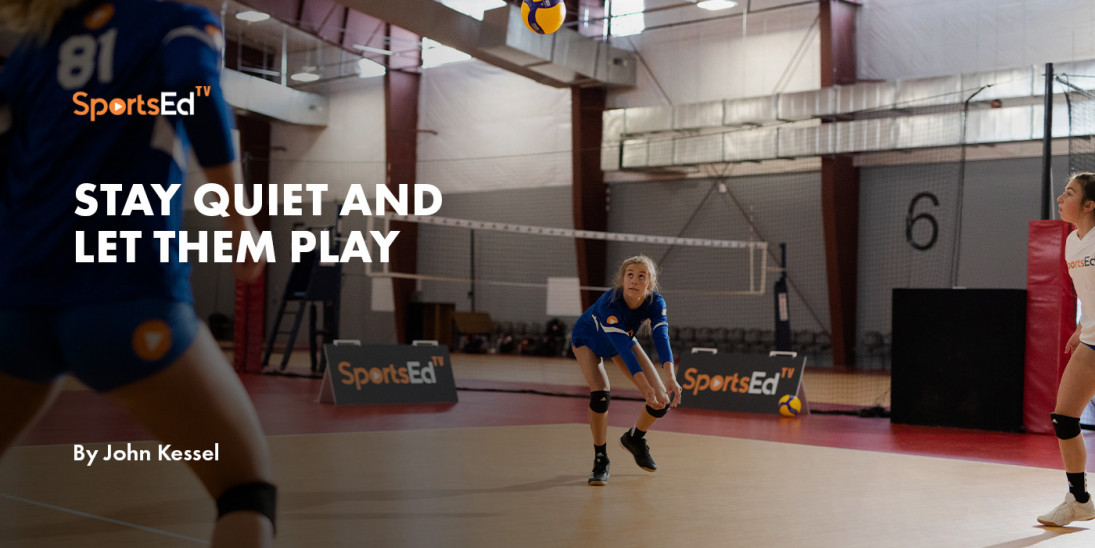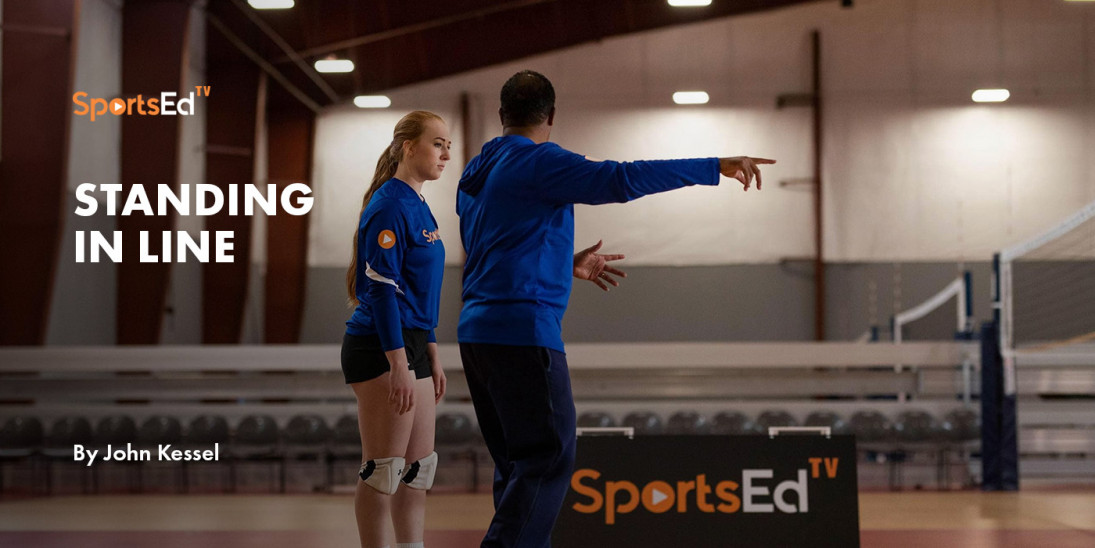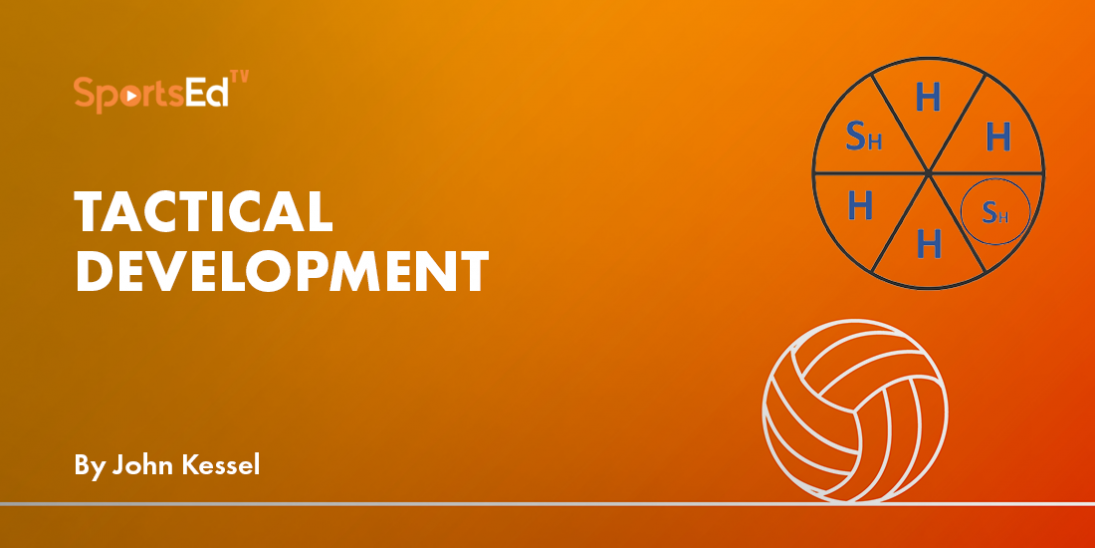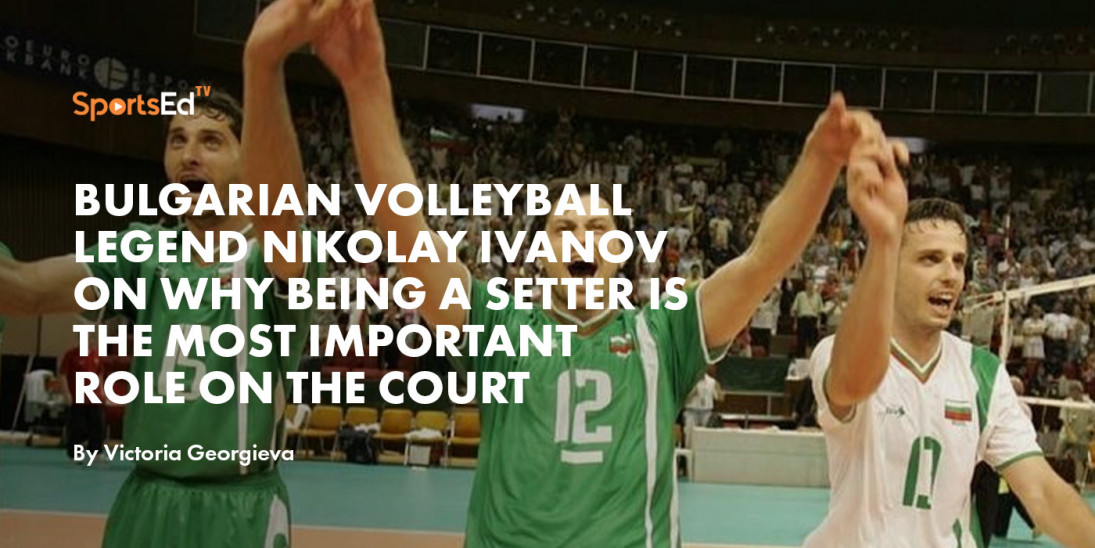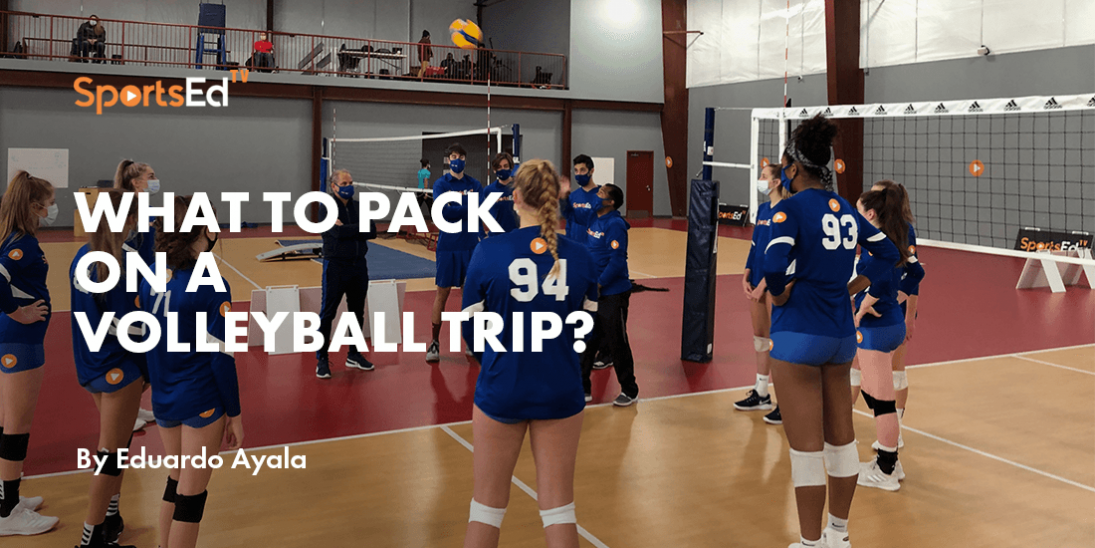Volleyball
Welcome and thanks for visiting...

CREATING KIDS’ VOLLEYBALL SUCCESS
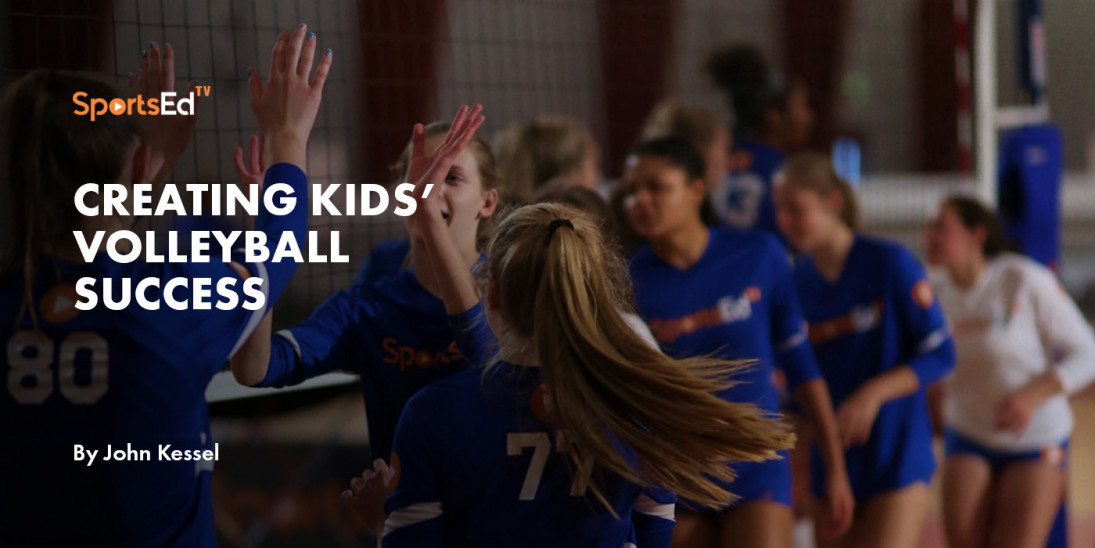
I have been coaching youth volleyball for decades. My definition of youth volleyball is 12 and under. In the last few years, I have seen growth in this area, but far too much of it simply is adults coaching the adult 6 vs 6 games to little kids. This leads to far slower learning of every important volleyball IQ area kids should be learning, as the one player touching the ball and 23 watching lack of doing in tournament play, leads the adults to do drills in practice – where kids either stand in line not learning, or learn the irrelevant “skills” of pair passing, usually from the same side of the net, ignoring the vital importance of the regulatory stimuli of the net itself. So some thoughts, from gems hidden on the grassroots section of USA Volleyball and other ideas learned over the last couple of seasons of clinics and coaching…
VOLLEYBALL PAIR UP Pass/Set/Hit
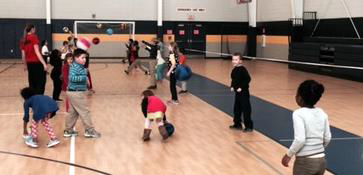 One way to combat the boring standing-in-line tradition of training youth is to run practices just in pairs – OVER the net and doing Receive/Set/Attack variations every time. You can serve back and forth to your pair partner, and starting with the setter at the ribbon/net who tosses to their partner, do receive (both forearm and overhead)/Set (lowest to start and higher as their reading/setting/attacking skills advance)/attack games. It is NOT about passing or setting the ball back and forth over the net on one hit – that is jungle ball and what traditional pair passing teaches. It is about receive/set/attack, no matter how young they are. When you run a long ribbon/net system – to get 25-40 meters of “net” and not 10 meters of a regulation net, you can lower the net for young ones and just get a whole class/group of 36 kids P/S/H in pairs, and get physical education/fitness by each group chasing their ball. You can put the ribbon nearer to one wall, not centered in the court/gym, so the chase is shorter and the time on task even higher. You can either lower the net/ribbon, as seen in this photo of 2nd graders – or hit from off the net – letting them know the “bic” (low 1 meter high) set they are hitting is one of four main back row spikes (A/Pipe /D are the others) they will see by the USA men and women’s Olympic team.
One way to combat the boring standing-in-line tradition of training youth is to run practices just in pairs – OVER the net and doing Receive/Set/Attack variations every time. You can serve back and forth to your pair partner, and starting with the setter at the ribbon/net who tosses to their partner, do receive (both forearm and overhead)/Set (lowest to start and higher as their reading/setting/attacking skills advance)/attack games. It is NOT about passing or setting the ball back and forth over the net on one hit – that is jungle ball and what traditional pair passing teaches. It is about receive/set/attack, no matter how young they are. When you run a long ribbon/net system – to get 25-40 meters of “net” and not 10 meters of a regulation net, you can lower the net for young ones and just get a whole class/group of 36 kids P/S/H in pairs, and get physical education/fitness by each group chasing their ball. You can put the ribbon nearer to one wall, not centered in the court/gym, so the chase is shorter and the time on task even higher. You can either lower the net/ribbon, as seen in this photo of 2nd graders – or hit from off the net – letting them know the “bic” (low 1 meter high) set they are hitting is one of four main back row spikes (A/Pipe /D are the others) they will see by the USA men and women’s Olympic team.
TWO VS. ZERO
No matter what their age, from simply doing overhead passing only on all three contacts, to reaching a level of dig/receive – set, overhead attack play. There is nothing more valuable than having the REAL ball control that comes with this warm-up/game. You can cooperatively score it, to set team/program records for in-a-row, and transition score it, where the pair cooperates to a certain number of net crossings before going full-on competitive for the rest of the point. They then reset and cooperate to that pre-determined number of net crossings.
LOSER BECOMES THE NET GAMES
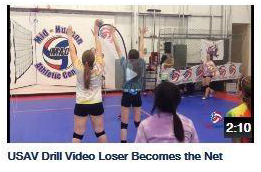 Everyone knows the monarch/queen/king of the court. So when just 3 or more kids are around, and no net, but they have a volleyball, just play 1 v 1 (3 hits a side) with the loser standing in the middle being the net. Got 4 kids? One team is doubles and plays regular. Same with five, only two doubles teams. Then when you get to six players, you can choose to play TWO groups of 1 v. 1 or one group of 2 v. 2 with each time the team losing the point standing in the middle (some kids might call this monkey in the middle from other sports games) arms raised and become the “net.” The net should be able to block – to learn to keep the sets off the net, but only the smaller players should be able to jump as the net. The idea is that the net can “jump” in order to get the “net” to be the women’s 7’ 4 ¼” net height or men’s 7’ 11 5/8” height (boys 15 and older play on the men’s height net). Higher-skilled kids you challenge real ball control by saying how they have to hit it over the net, including with the non-dominate hand. Remember to keep score, every time you stay on, you get a point.
Everyone knows the monarch/queen/king of the court. So when just 3 or more kids are around, and no net, but they have a volleyball, just play 1 v 1 (3 hits a side) with the loser standing in the middle being the net. Got 4 kids? One team is doubles and plays regular. Same with five, only two doubles teams. Then when you get to six players, you can choose to play TWO groups of 1 v. 1 or one group of 2 v. 2 with each time the team losing the point standing in the middle (some kids might call this monkey in the middle from other sports games) arms raised and become the “net.” The net should be able to block – to learn to keep the sets off the net, but only the smaller players should be able to jump as the net. The idea is that the net can “jump” in order to get the “net” to be the women’s 7’ 4 ¼” net height or men’s 7’ 11 5/8” height (boys 15 and older play on the men’s height net). Higher-skilled kids you challenge real ball control by saying how they have to hit it over the net, including with the non-dominate hand. Remember to keep score, every time you stay on, you get a point.
FOUR NETS ON A ROPE COMPETITIONS
Kids should be playing 2 v 2 as much as possible at this age. The four nets on a rope system (or ribbon/rope courts), allows you to get 8-16 doubles teams to compete on one regular adult court. Eight teams in a fast round-robin timed games to 5-12 min each (there will be 7 rounds, so 5 min games take a half hour and 12 min games take about 90 min. For 12 teams, you do timed 3 team pools on the 4 courts take another 50% longer. Sixteen teams have you playing speedball for a certain amount of time, then rotate the winners “up” one way and the lowest scorer of the four teams the other way, so that quickly over the competition period the better teams play each other and the less skilled teams are competitive against teams more at their level. Note that in starting kids' programs, it is better to NOT ask for the whole game, but rather just half the gym. Run the four nets from side basket to side basket in half the gym and let the kids soccer/basketball/other sports see your group having so much action and fun on your side.
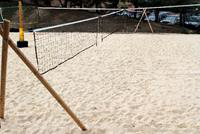 Outdoors, if you link run TWO sets of 4 nets on a rope on two adult sand courts, you can do the above variations, getting twice as much play happening. Yes, it is possible to have 32 teams, a grand total of 64 kids, playing doubles on just two adult sand courts. On grass courts, the same, and if there are more full-sized courts, you can put up each with 4 nets on a rope (most commonly using wooden “X” standards staked out). And get 32 kids more per adult court, or put three or two, not four, larger and wider courts. Down the middle of each adult court. Of course, you can also play doubles on the full-sized 8x16m courts. In Vail when I run outdoor clinics (CLICK HERE on how I run those), I have had as many as 16 full grass doubles courts in a line, and simply tell the one team to stay, and everyone else to rotate, and with 4 min timed games, you get everyone to play everyone in one hour.
Outdoors, if you link run TWO sets of 4 nets on a rope on two adult sand courts, you can do the above variations, getting twice as much play happening. Yes, it is possible to have 32 teams, a grand total of 64 kids, playing doubles on just two adult sand courts. On grass courts, the same, and if there are more full-sized courts, you can put up each with 4 nets on a rope (most commonly using wooden “X” standards staked out). And get 32 kids more per adult court, or put three or two, not four, larger and wider courts. Down the middle of each adult court. Of course, you can also play doubles on the full-sized 8x16m courts. In Vail when I run outdoor clinics (CLICK HERE on how I run those), I have had as many as 16 full grass doubles courts in a line, and simply tell the one team to stay, and everyone else to rotate, and with 4 min timed games, you get everyone to play everyone in one hour.
If you only have 8 or so kids, play 1 v 1 Speedball on two courts or just 1 v 1 on all four courts. That just happens to be how the creator of volleyball gave as the second rule of the game – where just one person played on a side (or two, or three or more….its where the term “side out” came from). To see court-size examples CLICK HERE.
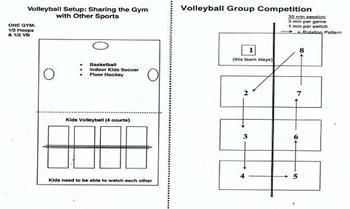
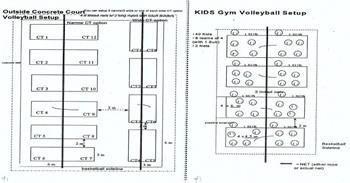
TWO-CONTACT GAMES
Once the players' volleyball experience and IQ is ready, limit the contacts per side to two. Things will get uglier/more random/chaotic. Each side, from small court doubles teams to six a side, will get 50 percent more chances to read the ball coming over the net. The more chaotic game version can be done for maybe 25 percent of your gameplay. I have blogged previously about a national team favorite warm-up known as “vollis” where both sides cooperatively then competitively send the ball back and forth with just one hit (and no bounce). There is “chaos,” where TWO balls get served at the same time. The game ends when one side gets both balls to be a point. When one ball is down, you can “revive” the ball by serving it to the opponent side before the second ball becomes a point also. Chaos, as a warm-up for any age and sized court, usually has no jumping and one to three contacts per side is required. When teams warm up with balls and over the net, they get better at volleyball while moving a lot.
SITTING VOLLEYBALL
Too often, programs lose their gym space. Rather than cancel the practice, play sitting volleyball (or play outside if the weather and time of day allow). Share the court that is available as you can set up THREE sitting courts on one regular indoor court - endline to 3 meter line/3m line to 3m line/3m line to other endline. Put two chairs centered on each endline and tighten the ribbon or rope and play. The court is .5m short officially, but who cares? The athletes will get better at overhead skills, laugh and learn more about the Paralympic version of the game. There are only four rule differences from the Olympic version: 1) Blocking the serve is ok; 2) Feet can be over lines or under the net as long as the bottom is behind the lines; 3) No “butt lift.” You must stay on at least one cheek when blocking or attacking; 4) Do not go lower to defend, set or receive. Put the ribbon/rope over the top of the chair back, and secure it with something heavier – a weight plate from the weight room, a 50 lb pet food bag or even someone sitting in the chair (seen in these pics).
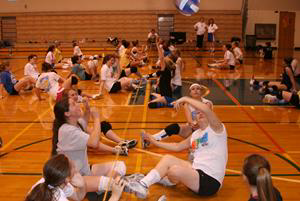
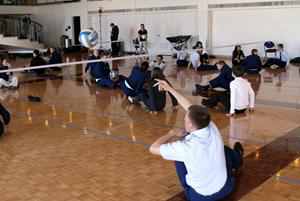
KIDS COACHING YOUNGER KIDS
That which you teach, you learn. Sadly, many programs feel you need adults to teach kids at all levels. There are even programs where parents teach their kids one-on-one. Around the world, high levels of play by kids 11-12 years of age, have them teaching up to half their practice to the 7-10-year-olds. The only adult you need is the head coach, who is there to guide the discovery of the older kids while they teach the younger kids in one, two, and three-person groups/teams. These young coaches become better players by coaching it, and are great, fitting role models for those just a few years younger than themselves.
ONE/TWO VS. FOUR/FIVE/SIX
Some days you might only have 5-6 players. You certainly can help quickly give the server or teams of a 2/3 vs 3 game balls quickly, so as to increase the contacts per hour. As they get better, it is also a good reward and challenge to have side just be one or two players maximum. This solo or pair team plays the remainder of the squad at practice. You can rotate thru, so every player sees how many points they can score in a set amount of time. You can also let the player on the larger numbered team size who earns the point to replace one of the pair/solo team players, swapping positions on the fly between serves. Count out loud to two seconds before the serving team can serve, to make sure they hustle and anticipate both having a ball ready to serve and moving fast to the pair/solo team side. PLAY COED Whether you play with or against adults, or boys, competing against older/more experienced players and boys simply adds to any girls’ team practice. Boys playing men is the same. This is a non-contact game we play and kids might lose on the scoreboard at the start, but they can learn faster by playing those faster and better than they are. Coed play is underrated in developing younger players' skill sets.
THREE TEAM POOL EVENTS
So families can stay more local yet get nearly as many matches in an evening as they do in a day-long tournament. This is for full-court doubles, triples, four and six-person team sizes playing. These pools are only three rounds, with the off-team refereeing. Even the smallest gyms should be able to fit in two courts if six hoops are up in the same gym. Playing either timed matches of 45 min or best two of three to 21 (starting at 4-4), the pool play rounds take just over 2 hours, then the finals take place where the #1 teams from each pool compete on court 1 and the #2 teams playoff on court 2, with the #3 teams from the pools refereeing. In just over three hours four of the six teams have played three matches.
If you form these two court events into a chain of competition, each round you can advance the #1 team into a higher group, and move the team, or teams, finishing 3rd in the pool to a lower group.
You can do these three-hour competitions on Friday evening – we call them date nite competitions/leagues which allow the parents to have time for dinner and a show. You can do them Saturday mornings, from 8-11, so the families have time for other activities, or Sunday afternoons/early evenings, after church.
In every case with athletes of any age or experience, you check them without the ball to see if they grasp the actual technique, by their showing you what they think it looks like. Once you are confident they know it, even when you don’t see it in the game played above, you keep guiding them to learn how to be in the right place and time to best do each skill technically. The youngest can play with a balloon or beach ball to slow the flight time down, and on these smaller courts where the ball does not fly as fast or far. Still, they should be playing over the net, not ignoring it, and having fun.
SEE HIGHER-LEVEL VOLLEYBALL
If you begin with the end in mind, you start by showing young players volleyball rallies like those found in the USAV Grassroots section called “Longest Rallies Awards.” This way they understand first off the game is three contacts, with lots of movement and rallies. Then it is time to take them on a “field trip” to watch a high school or college game, of either gender. With lead time for larger groups, many schools will both arrange for free admission, and even a chance to meet/greet the team before or after the match. Even a Park and Rec Men’s/Women’s/Coed highest level of league play can substitute, with under an hour of play the kids experience what real volleyball is and can be. The National Collegiate Volleyball Federation has a season from fall to mid-April for their nationals, and those men and women would LOVE to have kids come to watch their practices or tourneys on hundreds of college campuses from Oct to March, in the months leading up to nationals. It is also a way to show kids the options beyond playing varsity at the university level.
SET NO LIMITS BASED ON AGE
Finally, a reminder to those who think that young players don’t learn well from playing 2 v. 0 and small-sided games, I urge coaches and teachers of any age to take 12 minutes to break through those limiting beliefs. Note in advance some important things in this video seen now over a million times between the FIVB and USAV websites combined. 1. Boys are playing this game at a young and high level. 2. These are not all-star teams selected from tryouts and regional recruiting efforts; they are just kids from each school. 3. No attacked ball is hit into the net. Over the net and out is the only attacking error they make. 4. All but three digs go UP, onto their side, not over the net. CLICK HERE to watch the 2013 Thailand School VB Championships.



